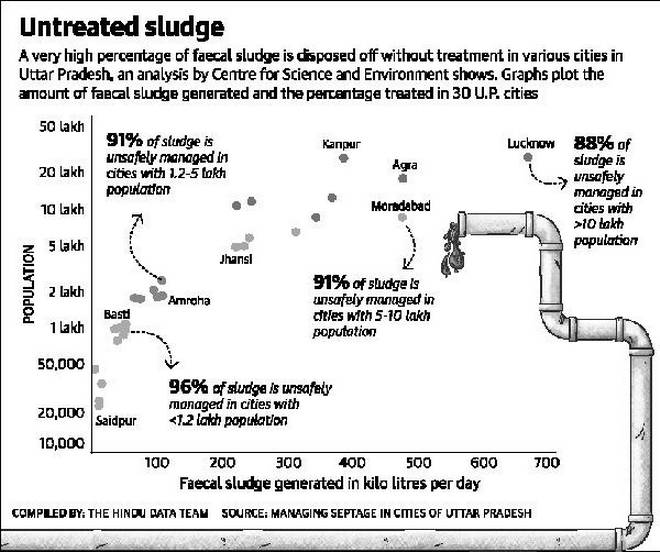What is the issue?
The Centre for Science and Environment recently released a report on its analysis of sludge management systems in 30 cities in Uttar Pradesh.
What are the highlights?
- Waterbodies - Urban Uttar Pradesh has an 80% coverage of toilets, but inefficient sanitation systems.
- So almost 87% of faecal sludge expelled from toilets in urban areas is untreated.
- This, in turn, is being dumped in waterbodies or agricultural lands.
- It is eventually leading to polluting the Ganga and other rivers.
- Systems - The number of toilets and onsite sanitation systems being built in the state are all set to increase exponentially.
- But the effluent from the septic tank, along with greywater from other uses flows out into stormwater drains and open drains.
- If not managed scientifically and sustainably, the amount of faecal sludge that new toilets will generate will swamp the State.
- It will only worsen the environmental, sanitation and manual scavenging situation.
- Manual scavengers - The faecal sludge has to be periodically emptied from the septic tank, either manually or mechanically.
- But half of all emptying work in the studied cities is done manually.
- This is despite the legal prohibition of the employment of manual scavengers.

What are the other drawbacks?
- State support for improved housing and planned development has never been strong.
- The National Urban Sanitation Policy of 2008 has not changed this condition significantly.
- At the national scale, a UN report of 2015 estimates that 65,000 tonnes of untreated faeces is introduced into the environment in India annually.
- The Swachh Bharat Abhiyan promised a major shift, but the focus is more on the basic requirement of household and community toilets in rural and urban areas.
- So the problem of waste not being contained, collected without manual labour, transported and treated safely remains.
What lies ahead?
- India aims to achieve clean water and sanitation for all, under the UN Sustainable Development Agenda, by 2030.
- Given this, decentralised sludge management systems are vital to achieve the clean water goals.
- Investments at this end would improve the environment and reduce the disease burden with insanitary conditions.
- The strategy for the Ganga relies on large sewage treatment plants for riverside cities and towns.
- The CSE study is being followed up with a mapping exercise on the flow of faecal waste streams in individual cities, which is welcome.
- One immediate intervention needed is the creation of an inter-departmental task force.
- This has to identify land to build small treatment systems for sludge.
- It should also provide easily accessible solutions to houses that are currently discharging waste into open drains.
- The business of emptying faecal material using tanker trucks needs to be professionalised and de-stigmatised.
- Caste factors still play out in the recruitment of workers even in the mechanised operations. (Click here to know more)
- So all aspects of the business of sanitation need reforms in India.
Source: The Hindu
